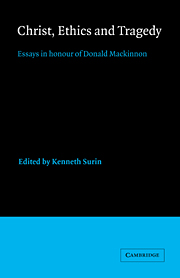Book contents
- Frontmatter
- Contents
- Preface
- Donald MacKinnon
- 1 Theological rhetoric and moral passion in the light of MacKinnon's ‘Barth’
- 2 Idealism and realism: an old controversy dissolved
- 3 Modes of representation and likeness to God
- 4 MacKinnon and the parables
- 5 Trinity and ontology
- 6 Some aspects of the ‘grammar’ of ‘incarnation’ and ‘kenosis’: reflections prompted by the writings of Donald MacKinnon
- 7 Tragedy and atonement
- 8 MacKinnon and the problem of evil
- 9 Pride and international relations
- 10 ‘Between purgation and illumination’: a critique of the theology of right
- 11 On being ‘placed’ by John Milbank: a response
- Index of names
- Index of subjects
7 - Tragedy and atonement
Published online by Cambridge University Press: 11 March 2010
- Frontmatter
- Contents
- Preface
- Donald MacKinnon
- 1 Theological rhetoric and moral passion in the light of MacKinnon's ‘Barth’
- 2 Idealism and realism: an old controversy dissolved
- 3 Modes of representation and likeness to God
- 4 MacKinnon and the parables
- 5 Trinity and ontology
- 6 Some aspects of the ‘grammar’ of ‘incarnation’ and ‘kenosis’: reflections prompted by the writings of Donald MacKinnon
- 7 Tragedy and atonement
- 8 MacKinnon and the problem of evil
- 9 Pride and international relations
- 10 ‘Between purgation and illumination’: a critique of the theology of right
- 11 On being ‘placed’ by John Milbank: a response
- Index of names
- Index of subjects
Summary
Only there is no escape from contingency.
Donald MacKinnonOne of the striking things about Donald MacKinnon's speaking and writing is the way he interprets the Bible. Frequently a passage is focused on, taken up into a discussion, and shown to be fruitful in ways that go beyond the horizons of most scholarly commentaries. Take, for example, his treatment of John, chapter 20 in ‘The Problem of the “System of Projection” Appropriate to Christian Theological Statements’. At the culmination of a complex argument involving logical implication, the relation of various types of language to reality and the status of the Resurrection of Jesus in Christian faith, John, chapter 20 is introduced as ‘one of the classical Christian documents concerning the relation of perceiving (and especially visual, auditory and tactile perception) to faith’. What happens in the interpretation that follows is worth noting.
The main thing going on is what might be called conceptual redescription of the text, like the German Nachdenken. The details of the story in all their complex inter-relationships are described in philosophical language, and thought tries to keep closely to the particularities of this text while also exploring its logic. The result is both to sharpen appreciation of the thrust and nuances of the text and to connect its narrative with some perennial philosophical issues. Yet for all the apparent neutrality of the attempt simply to describe, the implications of this approach can be considerable.
- Type
- Chapter
- Information
- Christ, Ethics and TragedyEssays in Honour of Donald MacKinnon, pp. 117 - 130Publisher: Cambridge University PressPrint publication year: 1989
- 2
- Cited by



